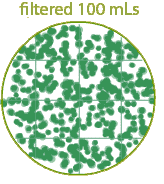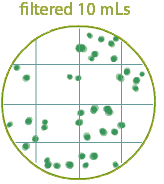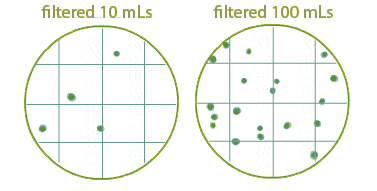How do we count them all?
Luckily for us, we don’t need to count all of those millions of descendants of Rocky and Terry and all the others. All we care about is counting the original colony forming units, or CFUs. In other words, just the original Rocky and Terry. And we can do this because Rocky left a pile of descendants, and Terry left a different pile someplace else.
So, that becomes our basic modus operandi:
- get a sample of water, and keep it cold, so that the enterococci will not reproduce
- put the sample on a plate, getting rid of all the water, so just the CFUs are left
- let the CFUs on the plate grow and multiply in comfy conditions for 24 hours.
 count the colonies.
count the colonies.
The hardest part of all of this is keeping really clean so that so your results are valid. Otherwise its not hard to understand. But there is one wrinkle. We need to count the number of CFUs per 100 mL of water, but we don’t know if advance how many there will be (duh! otherwise we wouldn’t need to count them!!) Let’s say there is an infestation of enterococci (400 per 100mL of water). If you filter 100 mL of water and plate the sample, after 24 hours, your plate will look something like this:
And you won’t want to count that mess!!
 So, one solution is to filter only 10mLs of water. Let’s say you did that and got a plate that looked like the bottom plate:
So, one solution is to filter only 10mLs of water. Let’s say you did that and got a plate that looked like the bottom plate:
How many CFU’s are on this plate?
How many CFU’s would there be in 100mL:
What if your water has very little infestation?
So far so good. If you have a high infestation, you're better off counting the 10mL plate. But what if you have water with almost no infestation? Then your plates might look like this:

Well, the 10mL plate is easy to count, but maybe not too accurate. If you happened to get just a few more CFUs, it would look like your contamination rate doubled! So you’re better off filtering 100mL of water. Then an extra CFUs won’t make too big a difference.
For these 2 plates, we would estimate contamination as
So we should filter 10 mLs if we have lots of enterococci and poor water quality, but 100mLs if we have few enterococci and good water quality. The only problem is, we don’t know in advance which one its going to be...
Copyright University of Maryland, 2007
You may link to this site for educational purposes.
Please do not copy without permission
requests/questions/feedback email: mathbench@umd.edu